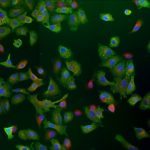Lien vers Pubmed [PMID] – 36730204
Lien DOI – 10.1073/pnas.2211098120
Proc Natl Acad Sci U S A 2023 Feb; 120(6): e2211098120
The segmented RNA genome of influenza A viruses (IAVs) enables viral evolution through genetic reassortment after multiple IAVs coinfect the same cell, leading to viruses harboring combinations of eight genomic segments from distinct parental viruses. Existing data indicate that reassortant genotypes are not equiprobable; however, the low throughput of available virology techniques does not allow quantitative analysis. Here, we have developed a high-throughput single-cell droplet microfluidic system allowing encapsulation of IAV-infected cells, each cell being infected by a single progeny virion resulting from a coinfection process. Customized barcoded primers for targeted viral RNA sequencing enabled the analysis of 18,422 viral genotypes resulting from coinfection with two circulating human H1N1pdm09 and H3N2 IAVs. Results were highly reproducible, confirmed that genetic reassortment is far from random, and allowed accurate quantification of reassortants including rare events. In total, 159 out of the 254 possible reassortant genotypes were observed but with widely varied prevalence (from 0.038 to 8.45%). In cells where eight segments were detected, all 112 possible pairwise combinations of segments were observed. The inclusion of data from single cells where less than eight segments were detected allowed analysis of pairwise cosegregation between segments with very high confidence. Direct coupling analysis accurately predicted the fraction of pairwise segments and full genotypes. Overall, our results indicate that a large proportion of reassortant genotypes can emerge upon coinfection and be detected over a wide range of frequencies, highlighting the power of our tool for systematic and exhaustive monitoring of the reassortment potential of IAVs.








